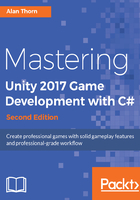
What this book covers
Chapter 1, Preparation and Asset Configuring, outlines the project we’ll focus on in the book. It specifies tips and tricks for importing assets optimally, configuring assets, and best-practice workflows for keeping your project organized.
Chapter 2, Level Design and Structure, here, gets you started with designing and building the main game level inside Unity, taking a look at interesting level-design ideas as well as critically important practical considerations.
Chapter 3, Player Controls - Movement, explores player controls, that is, how player input drives and controls the main game camera.
Chapter 4, Player Controls – Typing and Health, says that every character that can take damage needs health, representing the total amount of damage a character may sustain. In this chapter, we’ll focus on creating a combat mechanic that damages enemies.
Chapter 5, Enemies and Artificial Intelligence, informs that enemies need to behave intelligently and believably; this chapter looks at how to achieve that using AI. By using AI, enemies will move around the level, seeking the player, and will attack when in range.
Chapter 6, Project Management and Version Control, looks at ways to optimize the game development workflow using Version Control software. This keeps a record of our project as it moves through all its iterations.
Chapter 7, Persistent Data – Load and Save Game States, explains that players often want their in-game progress saved, allowing them to resume where they left off previously every time they start a new play session. This chapter covers the different saving methods available in Unity.
Chapter 8, Performance, Optimization, Mobiles, and More, outlines a selection of related topics as the final chapter of this book. Specifically, it takes you through how to improve the performance of your games through optimization, how to prepare your games for mobile deployment, and how to prepare generally for VR development.